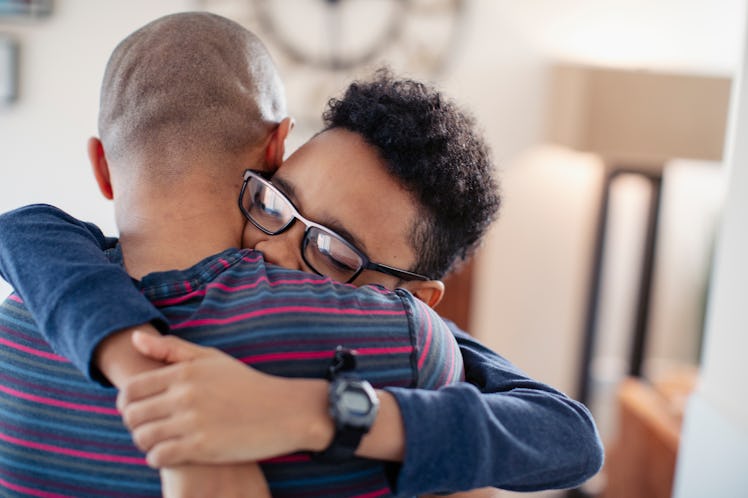Why You Should Hug Your Kid For At Least 20 Seconds
The benefits are seriously worth it.

Earlier this summer, a father of two adult children posted in the Daddit community on Reddit about how much he loved giving his kids 20-second hugs. “When they were young we'd count to 20 together and that was part of the fun. Sometimes it would be calming, sometimes goofy,” he wrote. Now that they’re adults, if his kids forget to give him a Father’s Day or birthday gift, he always asks for a 20-second hug instead. “This will now continue until I pass, I'm sure.”
A few days later, a recently divorced dad of two girls shared that, while he always hugged them, until he read that thread his hugs were much quicker. “I feel them relax at the 10 second mark and I’m grateful for the tip.” And more recently, another dad in the same community flexed that his son and him had worked their way up from 10-second hugs to 3-minute ones.
It’s fair to say there is something about the 20-second hug that hits home, or rather snuggles its way there. But what is the power of the 20 second hug, specifically? And if so, isn’t that kind of a long time?
The idea of a 20-second hug did not originate from Daddit, but from a 2003 study that found that hugging for 20 seconds noticeably reduces blood pressure, heart rate, and stress. Although this research was conducted on cohabitating couples, psychologist Tracy Packiam Alloway, Ph.D., (who was not involved in the study, but has written about the topic for Psychology Today), believes these benefits extend to parent-child relationships. This is mostly because the sensation of cuddling appears to trigger a deeply rooted, instinctual sense of safety and comfort. Twenty seconds is the generally accepted threshold for releasing feel-good bonding chemicals like oxytocin that flips this switch.
Alloway, who is a psychology professor at the University of North Florida, cites other evidence that simply hugging a pillow can cause comparable stress reductions, so the 20-second hug is really not about a romantic connection at all.
She suspects that similar to power posing for confidence or smiling to boost your mood, hugs are another physical way to shift our mental well-being in a positive direction. “The physical movement of even hugging a pillow takes you back to that safe, physical feeling of being in the womb,” she told Fatherly.
That said, other research shows that there is a big difference between parent-child hugs and any other type of embrace. By using something known as an R-R interval (RRi) test, scientists discovered that when parents hugged their babies, infants displayed lower heart rates and increased parasympathetic activity, an indicator of lower stress. Conversely, when infants were hugged by a female stranger, the same effects were not achieved.
It’s worth noting that there are a lot of variables that can limit the duration of hugs with your kids, including their developmental stage, attention spans, sensory issues, and individual personalities. “Some kids have a big problem with being restrained, so even if that hug is offered to soothe them or offer support, they may be over it,” says developmental psychologist Andrea Bastiani Archibald, Ph.D.
Archibald has previously spoken out on why it’s important to not make children hug their relatives when they don’t want to. She first commented on this in 2017 at the height of the Me Too Movement, and the message was geared towards daughters. However, the same premise applies to boys, she says. In fact, by respecting boys’ physical space, you’re teaching them to respect other people’s boundaries by modeling that behavior. So if they don’t want a 20-second hug, don’t force it.
“We have to give all children the agency to share the ways in which they feel and put up boundaries,” Archibald says. “We want them to trust their guts. We have to allow them to show affection in a different way.” Archibald has a son who’s kindergarten teacher, for example, let children choose between a hug, a high five, or a “Hollywood,” which is two air-kisses.
As a parent herself, Archibald acknowledges that it’s not entirely reasonable to expect moms and dads to walk around asking their kids for consent every time they hug them. Rather, the parent-child relationship is something more intuitive than the relationship a kid would have with a teacher, grandparent, or aunt. As Archibald’s kids grew up, she learned that one of them was more of a hugger and the other was not. Like her, most parents acclimate to how their children prefer to be comforted over time.
After all, the comfort and bonding of a 20-second-hug only works if your kid wants to do it. If it stresses them out, they’re not going to have a lower heart rate afterwards. And if your child doesn’t want to sit still for a hug that long, that doesn’t mean there’s anything wrong with them or your relationship, so don’t take it personally.
If you’re worried about how long you should be hugging your kid for, that might be an indicator that you need to work on your communication with your child, or trusting your intuition as a parent — or perhaps a combination of both, Archibald adds.
“There are moments when a longer hug is totally appropriate and necessary,” she says. “But then there are moments when that’s unnecessary and the child isn’t in the same mode as you are. So I’m not a fan of putting time limits on hugs.”
This article was originally published on